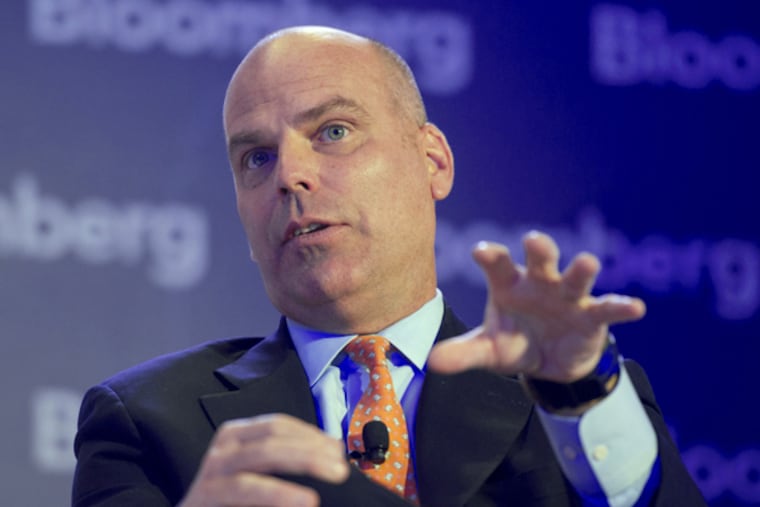Toll Bros. CEO looks back at debacle, ahead with confidence
It was in the depths of the real estate downturn, June 2010, that Robert I. Toll, cofounder of the luxury home builder Toll Bros. Inc., stepped down as chief executive officer and handed the reins to Douglas C. Yearley Jr.

It was in the depths of the real estate downturn, June 2010, that Robert I. Toll, cofounder of the luxury home builder Toll Bros. Inc., stepped down as chief executive officer and handed the reins to Douglas C. Yearley Jr.
The move had been in the works for a while, but as Yearley recalled in a recent interview at corporate headquarters in Horsham, "Bob wanted to wait a bit until the market showed signs of improvement."
"He didn't want to dump a huge mess into my lap," said Yearley, 53, who joined Toll Bros. in 1990 as "executive assistant" and spent the early years making deals with the Resolution Trust Corp. for distressed land.
As it turned out, he didn't inherit a huge mess. Toll Bros. fared better through the housing bust than many other builders, and the market has seen improvement, "though not always steady," since then, Yearley said.
"If you look at things now and back at June 2010," he said, "home-building, the economy, and Toll Bros. have all changed for the positive," starting in 2012 and through the first half of 2013, when, builders and Realtors acknowledge, real estate activity plateaued.
"Everything we've done along the way has us heading in the right direction," he said. "We are bigger, stronger, and more diversified, and primed for continuation of the recovery. We feel good about 2014 and beyond."
These days, the market is flat. That's due, in part, to an interest-rate spike in June that saw fixed mortgage rates rise from 3.5 percent to 4.25 percent in just three weeks. (Rates are now about 4.5 percent, according to Freddie Mac's weekly survey.)
Though interest rates might not affect Toll Bros. buyers, they might deter the people to whom they are selling their current homes, Yearley said.
Moreover, builders have raised prices in the last 18 months, and production remains at its lowest level in 40 years, meaning there are fewer houses to sell.
"Buyer confidence remains fragile," Yearley said, "and many are sitting on the sidelines" to see whether rates and prices drop.
'Imploded'
During the prolonged downturn, Toll continued to acquire land to be "in position to take advantage of the return of consumer confidence," he said. With a balance sheet showing "as much as $2 billion in cash" at times, "it allowed us not to worry about payroll, but how we could buy ground for the next cycle."
Land deals are "very market-specific," he said, and "everything that was good in this one [Pennsylvania and New Jersey], we bought."
The slump caused Toll's competition for land here to "vaporize, private builders imploded, and most publicly owned ones pulled back or out" to the edges of the region, Yearley said.
In California, where Toll has built since the 1990s, there were many rivals for the home-building operations of Shapell Industries and its 5,200 lots, for which Toll paid $1.6 billion this year. Other growth areas for the company are Boca Raton, Fla., and the Dallas and Houston markets, Yearley said.
"Texas isn't the game-changer Shapell was, but it is a welcoming environment, our division is growing, and we have two large master-planned communities in Houston," he said.
Another game-changer for Toll in recent years has been its 10-year-old City Living division, especially its New York and Philadelphia projects, such as Naval Square and now 410 at Society Hill, between Front and Second Streets.
The division has 25 properties, eight under construction, and eight in the planning stages - from $500,000 to $20 million.
In Manhattan, 400 Park Ave. S. - condos $1 million to $10 million-plus - is now topped out at 42 floors and due for completion in 2014.
Thus far, the Philadelphia efforts have been low- and mid-rise, and though Yearley wants to do high-rise here, "it is a struggle," he said.
"In New York, it costs $350 a foot to build, but sells for $2,000 a square foot," he said. "In Philadelphia, it costs $350 a foot to sell for $600 a foot."
The experience of building in cities, especially New York, often catches Yearley off-guard. (In the 1980s, he rehabbed an older house off Haddonfield's Warwick Road.)
Take 205 Water in Brooklyn's Dumbo neighborhood under the Brooklyn Bridge, designed to look like an old industrial warehouse, but brand-new.
No accident
The steel beams, for example, were designed so that when they rusted, it would run down the exterior walls of the building.
When Yearley walked in the front entrance, he saw that the concrete floors were cracked and suggested they be replaced.
"I was told that we paid to crack it."
He noticed that a wall visible from some of the units was covered with graffiti.
"Should we do something to clean that?" he asked.
The reply, he said: "Do you know how much we paid to have it done?"